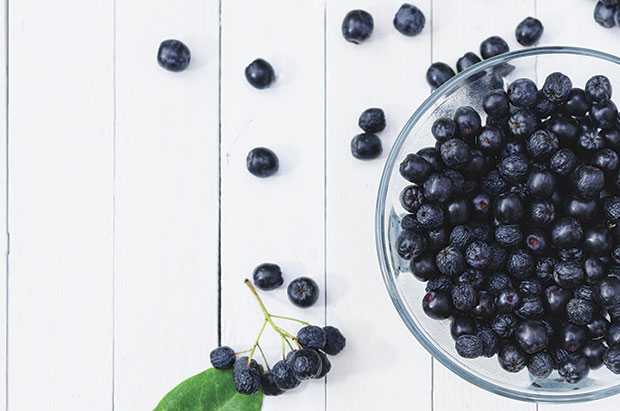


If there’s one piece of nutrition advice that I’m certain you’ve been told, have read about, or maybe have even passed along to others, it is you should avoid fruit when trying to get lean. The advice stems from research that implicates fructose—aka fruit sugar—and high-fructose sweeteners as stimulating fat gain and not providing a suppressing effect on food intake when consumed. Despite such data never using whole fruit as the delivery form of fructose, ad hominem bro reasoning has led to the Neanderthal-like reaction of “Fructose bad. Fructose is fruit sugar. Fruit bad.” Instead, research shows that digestion rate and source of fructose, not the total amount of naturally occurring fructose, is the real problem.
One very good reason physique athletes shouldn’t stop consuming fruit is because certain fruits—namely berries—are some of the richest food sources of polyphenols, which have been shown to provide a host of benefits critical to developing muscle and reducing body fat. A few other good reasons to eat berries are:
• Reduce the glycemic effect of otherwise high-glycemic foods (improve carbohydrate metabolism)
• Improve insulin sensitivity, insulin secretion, and fasting blood glucose
Reduce inflammation and accelerate healing/recovery
• Increase antioxidant capacity, and reduce reactive oxygen species and tissue damage
• Improve gut microbiota
• Increase beta-oxidation in fat tissue and decrease fat storage
• Improve brain function
• Protect against certain cancers
• Improve cardiovascular function and fitness
• Increase nitrite conversion to nitric oxide (NO)
• Reduce the physical and visible effects of aging or sun exposure
Berries are also a low-glycemic, high-fiber, and high-vitamin and -mineral source, which makes them pound for pound (or gram for gram) some of the most powerful and nutrient-dense foods you can consume. Though there are many great berries all over the world, below is a list of the five best berries to improve your aesthetics that are avialable at almost any grocery store.
Black Chokeberries (Aronia melanocarpa)
A drought-, insect-, and disease-resistant ornamental plant native to North America, the black chokeberry ranked as the highest polyphenol-containing fruit and seventh overall polyphenol-containing food within a list of 100 polyphenol-rich foods and seasonings. Of the total polyphenols present, procyanidins are the most predominant, which may explain why black chokeberries are so effective at reducing inflammation, increasing antioxidant capacity and immune system function, improving brain function, and positively affecting health. Consistent with findings that polyphenols can boost metabolic activity, a pilot study found that 150 milligrams per day of a concentrated chokeberry powder increased body temperature and circulating norepinephrine in women. Chokeberries also provide about six percent of their fresh weight as fiber and are a great source of potassium, niacin, pantothenic acid, and the carotenoids beta-carotene and beta-cryptoxanthin.
Blueberries (Vaccinium angustifolium)
Otherwise known as the wild or lowbush blueberry, this fruit yields about 45 calories per 100 grams, is very low-glycemic, and provides up to 304 milligrams of total polyphenols per 100 grams of fresh berries. Unlike the other fruits, blueberries are amongst the highest sources of hydroxycinnamic acids (chlorogenic, coumaric, caffeic, and ferulic acid) and are unique because of the range of different types of anthocyanins they contain. Consuming blueberries or blueberry concentrates have been shown to significantly improve exercise recovery, reduce oxidative stress, increase the rate of peak muscle force recovery following muscle damage–inducing exercise, and increase markers of immune system health. At the cellular level, blueberry polyphenols have been shown to protect muscle cells from oxidative stress–induced catabolism.
Blackberries (Rubus fruticosus aggregate)
As its dark black color indicates, blackberries are very high in anthocyanin polyphenols. Approximately 80 percent of the total anthocyanins found in blackberries is in the form of the potent anti-cancer agent cyanidin-3-glucoside. That’s important to bodybuilders because just 0.16 percent of ingested anthocyanins are excreted in the urine, when healthy adults have consumed 200 grams of fresh blackberries. A rodent study answered the question of tissue distribution of ingested anthocyanins from blackberries: the prostate, testes, heart, and adipose tissue are the predominant tissues where cyanidin-3-glucoside is deposited. It’s yet to be studied, though, if consuming blackberries offers some specific support to testosterone, sperm health, or prostate function. Per 100 grams of fresh blackberries, this fruit is also a great source of dietary fiber (5.3 grams), vitamin K (19.8 micrograms), vitamin C (21 milligrams), and copper (165 micrograms), and contains some of the lowest amounts of sugars of all of the berries (4.3 grams).
Black Currant (Ribes nigrum)
This genetic relative of the gooseberry has one of the highest reported concentrations of anthocyanins of any plant—over three milligrams per one gram of fresh currant, or more than 85 percent of the berry’s total phenolic compounds. Very little of consumed anthocyanins are absorbed within the small intestine, but instead are metabolized within the large intestine where these polyphenols have been shown to be potent prebiotics. Specifically, anthocyanins have a positive impact on the growth of the beneficial microbiota Bifidobacterium spp, Lactobacillus spp. and Enterococcus spp., which is probably at least partially responsible for the anti-inflammatory and reduced fat accumulation response attributed to polyphenol-rich diets. For example, in lean and obese mice, concentrated black currant was shown to reduce bodyweight gained and improve glucose metabolism and gut health when fed a high-fat diet for eight weeks.
Dark Sour Cherries (Prunus avium)
Native to parts of Eurasia, the Middle East, and Europe, the dark and sour varieties of Prunus avium are an excellent vasodilator, anti-inflammatory, antioxidant, and nighttime recovery food. Reported to contain high and very bioactive concentrations of anthocyanins and chlorogenic acids, the sour cherry has also been shown to contain up to 13.5 micrograms of melatonin per one gram of fresh cherries. So a little more than one cup of cherries could deliver a minimally effective dose of melatonin to help improve sleep quality and nighttime recovery. But the high polyphenol concentration of cherries may do far more for your physique than help you recover. In a rodent study in which rats were fed a high-fat diet for 90 days or the same diet plus freeze-dried cherries, the cherry-fed rats realized a significant reduction in abdominal fat and percent body fat, inflammatory markers, and blood cholesterol.
*NOTE: The botanical classification of berries and what are generally or commercially identified as berries are quite different. For example, tomatoes, grapes, all citrus fruits, and even bananas are technically classified as berries, whereas raspberries and blackberries fall into what are called aggregate fruits. For this article, I’ve taken liberties to stick to the commercial categorization, which is to say the fruits with names that end with “-erry” (e.g., blueberry, cherry, et cetera).






















You must be logged in to post a comment Login